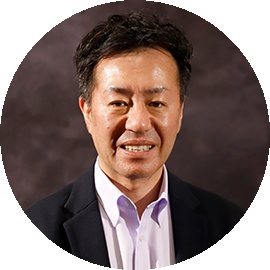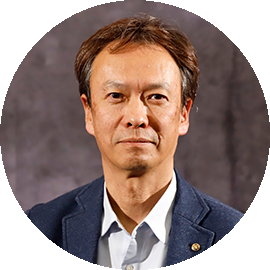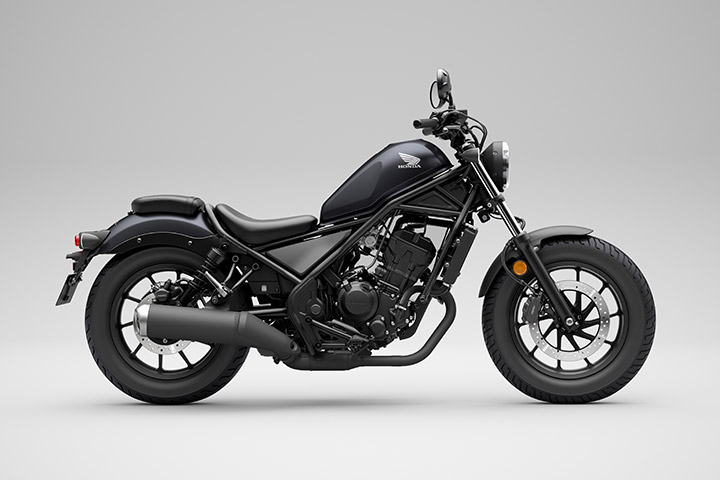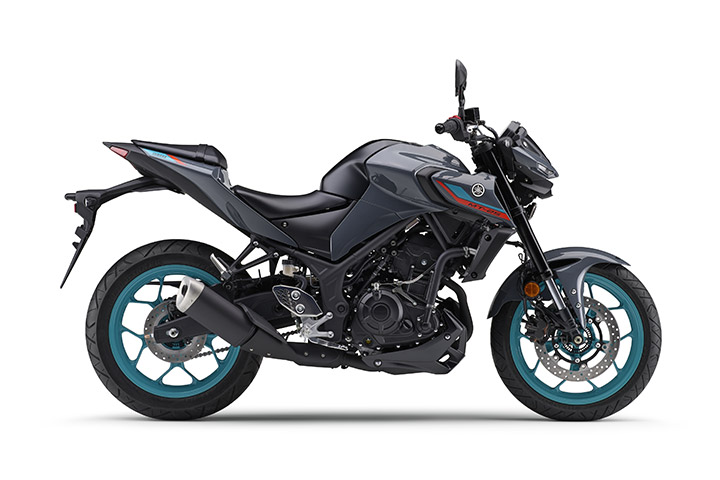Products
(Original issue date: March 20, 2023)
Continue Creating Safe and Fun Motorcycles -
Offering Changing Values and Timeless Attractiveness

Index
Electrified and connected models are becoming popular in the motorcycle industry. While the environment surrounding motorcycles is changing rapidly, motorcycles are once again attracting attention, especially among younger generations. In this era of social media and into a future where society will demand carbon neutrality, how will motorcycles change? Two engineers in charge of motorcycle development at Honda and Yamaha Motor, leaders and rivals in the industry, discuss what the future holds for motorcycles.

Operating Executive
Head of Monozukuri Supervisory Unit, and Chief Officer in Charge of Asaka of Monozukuri
Supervisory Unit, Motorcycle and Power Products Operations, Honda Motor Co., Ltd.,
Director of Honda R&D Co., Ltd.
Hikaru Tsukamoto
Joined Honda in 1994. After working on the testing of motorcycle handling as a member of the test team, Tsukamoto was appointed as the development leader of all off-road models. After serving as the first head of the motorcycle development division at Kumamoto Factory, he was assigned to the R&D center in Thailand where he spent 3 years before coming back to the R&D center in Asaka. Tsukamoto currently oversees the development, production, and purchasing of Honda motorcycles and power products. Personally, Tsukamoto is currently considering purchasing a Honda CRF250L.

Chief General Manager of PF Model Unit, and Senior General Manager of Motor Sports
Section, PF Model Unit Yamaha Motor Co., Ltd.
Toyoshi Nishida
Since joining Yamaha Motor in 1989, Nishida has been engaged in sports bike development, and is currently in charge of motorcycle development. Nishida is a genuine motorcycle enthusiast in his private life, and his favorite models include the TRACER9 GT and YPJ-MT Pro, the flagship model of Yamaha’s e-MTB (electrically power-assisted mountain bicycle) lineup.
Another motorcycle boom?
Shifting from a means of transportation to a tool for self-expression
Due partly to the lifestyle change people experienced during the COVID-19 pandemic, motorcycles are gaining attention as a socially-distanced means of transportation. Do you consider that we are seeing a comeback of the motorcycle boom?
 Tsukamoto believes social media has contributed to the recent popularity of motorcycles.
Tsukamoto believes social media has contributed to the recent popularity of motorcycles.
 Nishida
Nishida
I believe the meaning of the current “motorcycle boom” is different from the boom we experienced in the 1980s. I feel that going out on a motorcycle as a means of self-expression or communicating about yourself through your motorcycle is becoming more popular. Perhaps it is not so much the motorcycles themselves that are gaining momentum, but rather the use of motorcycles as a tool for self-expression.
 Nishida speaks from the viewpoint of someone who experienced Japan’s motorcycle boom in the
1980s.
Nishida speaks from the viewpoint of someone who experienced Japan’s motorcycle boom in the
1980s.
 Tsukamoto
Tsukamoto
I don't think this is a transient boom, but rather the gradual growth in recognition of the attractiveness of motorcycles, which seems to be continuing. In the past, motorcycles suffered a negative image, being associated with an increase in traffic accident fatalities of riders and “motorcycle gangs,” resulting in the “Three NOs campaign*1” targeting high school students in Japan. For a long time, motorcycles struggled with a negative public image. But now, combined with the popularity of outdoor activities, for instance, a greater number of women are actively choosing motorcycles as a transportation tool for outdoor activities such as camping, which indicates that more people started having a positive perception of motorcycles.
*1 A social movement that began in Japan in the 1970s to address the issue of increasing traffic fatalities, particularly due to the dangerous behavior of young motorcycle riders. The slogan, “Three NOs,” meant, “No to letting our kids get a motorcycle license,” “no to letting our kids buy motorcycles,” and “no letting our kids ride motorcycles.”
 Nishida
Nishida
I like looking at video sharing websites and social media. There are people driving a positive image of motorcycles on social media, and their high level of literacy has helped create a clean image of motorcycles. Maybe their followers see them as role models, with a sense of admiration.
What kind of changes happened to the mindset of riders now compared to that of riders in the past?
 Nishida
Nishida
I would say the atmosphere that makes some people avoid motorcycles as dangerous machines without giving any deeper consideration has not completely disappeared, but I see it as a positive that people are using motorcycles well with awareness of the risks.
 Tsukamoto
Tsukamoto
I think, in the past, most riders rode a motorcycle simply to ride a motorcycle. But now, more people are using motorcycles as a device or tool for them to do something else, expanding the range of motorcycle usage.
 Nishida
Nishida
There was a time when motorcycle prices kept going up, but some of the models Honda offers are reasonably priced and easy to customize. I believe that such models have widened the entry point to the market and stimulated the buyers’ mindset again.
 Tsukamoto
Tsukamoto
In the mid-size class, which targets younger generations, product prices went up, and thus the market entry point became narrower. Since the average age of motorcycle riders has been rising, we have been discussing how to attract younger riders. As a result of our discussions, we have been pursuing characteristics such as good foot grounding, lightweight, and ease of handling.
 “In Japan, the Rebel 250 is the most popular model now for Honda, the choice of a wide range of
customers,” said Tsukamoto.
“In Japan, the Rebel 250 is the most popular model now for Honda, the choice of a wide range of
customers,” said Tsukamoto.
 “For Yamaha, the most popular model in Japan is the MT-25. We place importance on offering models
in an affordable price range,” said Nishida.
“For Yamaha, the most popular model in Japan is the MT-25. We place importance on offering models
in an affordable price range,” said Nishida.
Differing philosophies behind Honda and Yamaha motorcycles
What differences and similarities are there between the Honda and Yamaha motorcycle philosophies?
 Nishida
Nishida
“FUN models” is a concept that is unique to Honda. We don't use such an expression very often at Yamaha.
 Tsukamoto
Tsukamoto
At Honda, we say, “FUN models” and “commuter models.”
 Nishida
Nishida
I think this expression indicates the different characteristics of the two companies. At Yamaha, “FUN” means “sport.” “Sport” exists first and FUN is a part of it. Because the roots of our company lie in musical instrument manufacturing, we think in this way: Even if you get a musical instrument, you cannot play it well at first. So, you practice and get better. Then music becomes more fun for you. So then, you want to get an even better instrument, and to make full use of that better instrument, you practice more. Then, you will be able to play even better music. Just like an instrument, motorcycle riders become better riders by practicing, and better riding skills make riding more fun, which makes you want to be an even better rider. This process of growing and getting better together with your motorcycle is, in itself, the “sport.”
 Tsukamoto
Tsukamoto
“We want to make our customers’ daily lives more enjoyable.” This is our underlying desire behind “The Three Joys,” which is a part of the Honda Fundamental Beliefs. This was the desire of our company founder, Soichiro Honda, and it became the starting point of Honda. In our mind, sport is one of the factors that makes people’s lives more enjoyable.
 Honda and Yamaha each have their own unique values.
Honda and Yamaha each have their own unique values.
Electrification and carbon neutrality: How will motorcycles change?
The Japanese government has declared that Japan will strive to achieve carbon neutrality, which means cutting greenhouse gas emissions to net zero, by 2050. To achieve this goal, the mobility industry is also being demanded to undergo a paradigm shift. What do you think will happen to motorcycles in the future?
 Nishida
Nishida
I believe the main purpose of achieving carbon neutrality is to address global warming, and
electrification is one direction we can take to contribute. If we become able to eliminate
CO2 emissions during the production of electricity and batteries and utilize more renewable
energy, I believe that going 100% electric may be possible in the future.
However, there are still many challenges to overcome, and I believe that a considerable
degree of technological innovation will be necessary. In the meantime, global warming will
continue. That being the case, there will still be people who need to travel using ICE
(internal combustion engine) vehicles in order to have enjoyable lives, and some people will
not want to give up the fun of ICE vehicles.
I believe that we still need to continue developing ICE technologies for a long while, so
that these people will not have to feel guilty or be forbidden to travel. Energy
conservation through improving the fuel efficiency of ICE will also become increasingly
important.
 Tsukamoto
Tsukamoto
Honda has officially announced a goal to make 100% of its global automobile sales EV (electric vehicles) and FCEV (fuel cell electric vehicles) by 2040. Honda has also set a goal to increase annual sales of electric motorcycle models to 1 million units by 2026, and to 3.5 million units, approximately 15% of total unit sales, as of 2030. These goals would not change our concept of offering the joy of mobility to as many users as possible. I believe the same is true for Yamaha. Without changing our fundamental concept, we will work on electrification, alternative energy and carbon neutrality.
 Nishida
Nishida
I think our approach to safety is what needs to change. Due partly to the spread of advanced driver assistance systems (ADAS), the number of fatal accidents involving automobiles has been continuously decreasing. On the other hand, the number of fatal accidents involving motorcycles has not decreased much. When our customers go out on a motorcycle saying, “See you later,” they must always come home with a smile on their face. There are so many things we want to achieve in order to realize a safer society, but we have limited time and resources available to us. In this sense, we need to take on challenges to make changes, including changes to how we work. We will change ourselves to create something new. We are working with that kind of mindset.
 Tsukamoto
Tsukamoto
As Mr. Nishida mentioned, safety is important. So Honda has announced that we would strive to halve the number of global traffic collision fatalities involving Honda motorcycles and automobiles by 2030, and strive for “zero traffic fatalities” by 2050. Honda motorcycles have been very popular in ASEAN nations. However, in Thailand, for example, an increase in the number of traffic collision fatalities has been an issue. In addition to addressing such issues as much as possible with our hardware, we believe there are other solutions we can offer, such as providing traffic education programs. Striving to make people’s daily lives more enjoyable, in addition to carbon neutrality, Honda will continue to work toward the enhancement of safety for everyone sharing the road.
What impact will the accelerating shift to electrification have on motorcycles?
 Nishida
Nishida
Regarding the argument that electrification will make motorcycles less fun, I think it depends on what users value most about motorcycles. Since electric power units, which are different from ICE, are available to us now, I think it is better to change our way of thinking and focus on how we can make motorcycles more fun than ever before. Electrification might make motorcycles more interesting, or indeed less interesting. Under such circumstances, fulfilling various customer demands is what makes an engineer’s job interesting and rewarding.
 Tsukamoto
Tsukamoto
I do not believe that electrification is necessarily an extension of ICE improvement, and it has not been decided that all ICE will be replaced by electric power units. We do, however, believe that we have a pretty good chance of gaining new users through electrification. While ICEs have evolved and matured over decades, various new companies are now producing EVs. In this startup period of the EV industry, we should consider our market share to be zero and create our EV products while considering ourselves as a new challenger in the industry.
 Both companies continue taking on challenges to develop safe and fun motorcycles.
Both companies continue taking on challenges to develop safe and fun motorcycles.
What is your vision for the future of motorcycles, considering the application of AI and connected technologies, in addition to the shift in power units?
 Tsukamoto
Tsukamoto
I am sure that AI applications and connectivity will continue to advance, but I personally believe that simplicity is important for motorcycles. If we think about what kinds of motorcycles are the best for us, with the aim of making our daily lives more convenient, I think the first thing we should do is to pursue simple things, such as long range and lightweight.
 Nishida
Nishida
Electric motors and batteries have become commodities around the world, and I feel that the barriers for entry into the mobility business have gotten very low. I think we should not compete on components. The only way to compete is to perfect each of our motorcycle products as a total package.
 Tsukamoto
Tsukamoto
At Honda, we believe that our history of being fully committed to fuel economy and durability will always be our strength as a motorcycle manufacturer. Integrated control is something that component suppliers cannot do on their own.
 Nishida
Nishida
Controlling how motorcycles behave is something only we can do, so we will communicate such strength as much as possible. Yamaha is also developing three-wheelers*2 that could be easily repackaged as all-electric models.
*2 Leaning Multi-Wheeler (LMW). While featuring a three-wheel layout—two at the front and one at the rear—the rider can make turns by leaning through corners like a motorcycle. Yamaha currently sells Tricity models and the NIKEN GT in its LMW lineup.
The market environment surrounding motorcycles is changing rapidly. In such an environment, how will Honda and Yamaha demonstrate their respective uniqueness?
 Nishida
Nishida
Part of the Unique Style of Yamaha is about striking a high-level balance between its elements of Excitement and Confidence. For “Excitement,” we would like to fully pursue the concept of “sport” and incorporate features which enable our products to grow along with our customers. Instead of offering instant fun, we would like to offer our customers the joy of practicing and growing, just like how people enjoy playing a musical instrument. The “Confidence” here is not the same as the absolute peace of mind Honda is pursuing for its customers. The idea for us is to not betray the expectations of our customers. Balancing these two at a high level is what makes Yamaha unique, and we will continue moving forward into the future with that belief.
 Tsukamoto
Tsukamoto
It may be a repeat of what I have said, but the uniqueness of Honda is that we focus on making people’s daily lives more enjoyable by helping people expand their life’s potential. There are thousands of ways to pursue carbon neutrality with ICE and with electrification. However, no matter how much our approaches change, our fundamental way of thinking remains the same. I believe this is what makes Honda unique.
 Honda and Yamaha leverage their respective strengths and carve out a new era of motorcycles.
Honda and Yamaha leverage their respective strengths and carve out a new era of motorcycles.
- Honda Stories
- Products
- Continue Creating Safe and Fun Motorcycles - Offering Changing Values and Timeless Attractiveness

I am not sure if “boom” is the right expression, but we do feel that more people in younger generations are beginning to realize the fun of motorcycle riding. There are some experienced riders taking up motorcycles again, while there are also young, novice riders as well.